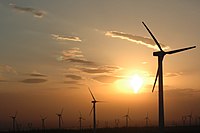
Photo from wikipedia
Air conditioning in buildings accounts for 60% of the total energy consumption. Therefore, accurate predictions of energy consumption are needed to properly manage the energy consumption of buildings. For this… Click to show full abstract
Air conditioning in buildings accounts for 60% of the total energy consumption. Therefore, accurate predictions of energy consumption are needed to properly manage the energy consumption of buildings. For this purpose, many studies have been conducted recently on the prediction of energy consumption of buildings using machine learning techniques. The energy consumption of the air handling unit (AHU) and absorption chiller in an actual building’s air conditioning system is predicted in this paper using prediction models that are based on artificial neural networks (ANNs), which simply and accurately allow us to forecast energy consumption with limited variables. Using these ANN models, the energy usage of the AHU and chiller could be predicted by collecting a month’s worth of driving data during the summer cooling period. After the forecast models had been verified, the AHU prediction model showed performance in the ranges of 13.27% to 15.25% and 19.42% to 19.53% for the training period and testing period, respectively, and the mean bias error (MBE) ranges were 4.03% to 4.97% and 3.48% to 4.39% for the training period and testing period, respectively. The chiller prediction model satisfied the energy consumption forecast performance criteria presented by American Society of Heating, Refrigerating and Air-Conditioning Engineers (ASHRAE) guideline 14 (the measurement of energy and demand savings), with a performance of 24.64~25.58% and 7.12~29.39% in the training period and testing period, respectively, and MBE ranges of 2.59~3.40% and 1.35~2.87% in the training period and testing period, respectively. When the training period and testing period were combined for the AHU data, the actual energy usage forecast showed a lower error rate range of 0.22% to 1.11% for the training period and 0.17% to 2.44% for the testing period. For the chiller data, the error rate range was 0.22% to 2.12% for the entire training period, but was somewhat higher at 11.67% to 15.18% for the testing period. The study found that, even if the performance criteria were met, high accuracy results were not obtained, which was due to the poor data set quality. Although the forecast model based on artificial neural network can achieve relatively high-accuracy results with sufficient amounts of data, it is believed that this will require a thorough verification of the data used, as well as improvements in the predictive model to avoid overfitting and underfitting, to achieve such good results.
Journal Title: Energies
Year Published: 2020
Link to full text (if available)
Share on Social Media: Sign Up to like & get
recommendations!